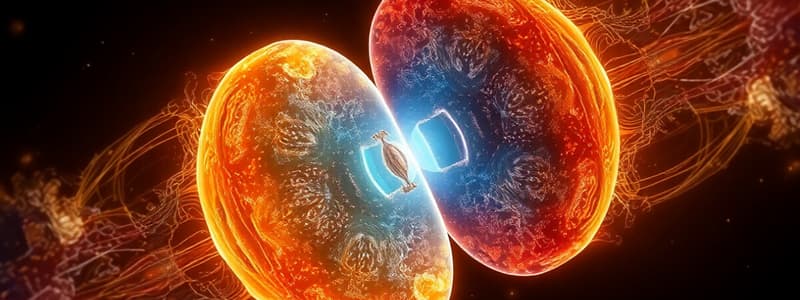Podcast
Questions and Answers
Mitosis results in four daughter cells, each with half the number of chromosomes as the parent nucleus.
Mitosis results in four daughter cells, each with half the number of chromosomes as the parent nucleus.
False (B)
During prophase, the nuclear envelope reforms and chromosomes decondense.
During prophase, the nuclear envelope reforms and chromosomes decondense.
False (B)
In prometaphase, microtubules from the mitotic spindle attach to the golgi apparatus on the chromosomes.
In prometaphase, microtubules from the mitotic spindle attach to the golgi apparatus on the chromosomes.
False (B)
Chromosomes align randomly throughout the cell during metaphase.
Chromosomes align randomly throughout the cell during metaphase.
The cell shrinks during anaphase as sister chromatids are pulled apart.
The cell shrinks during anaphase as sister chromatids are pulled apart.
Telophase concludes with the division of the cytoplasm, called karyokinesis.
Telophase concludes with the division of the cytoplasm, called karyokinesis.
In animal cells, a cell plate forms during cytokinesis.
In animal cells, a cell plate forms during cytokinesis.
Mitosis is essential for growth, repair, and sexual reproduction in multicellular organisms.
Mitosis is essential for growth, repair, and sexual reproduction in multicellular organisms.
The G2 checkpoint primarily assesses cell size and nutrient availability.
The G2 checkpoint primarily assesses cell size and nutrient availability.
Aneuploidy, resulting from errors in mitosis, always leads to immediate cell death.
Aneuploidy, resulting from errors in mitosis, always leads to immediate cell death.
Microtubules shorten by polymerization at the centrosome during anaphase to pull chromatids apart .
Microtubules shorten by polymerization at the centrosome during anaphase to pull chromatids apart .
Plant cells use centrioles to organize the mitotic spindle, mirroring the process in animal cells.
Plant cells use centrioles to organize the mitotic spindle, mirroring the process in animal cells.
Cyclin-dependent kinases (Cdks) are active without the presence of cyclins.
Cyclin-dependent kinases (Cdks) are active without the presence of cyclins.
Mutations in tumor suppressor genes promote uncontrolled cell division by accelerating the cell cycle.
Mutations in tumor suppressor genes promote uncontrolled cell division by accelerating the cell cycle.
The spindle assembly checkpoint (SAC) monitors the level of chromosome condensation to ensure proper segregation.
The spindle assembly checkpoint (SAC) monitors the level of chromosome condensation to ensure proper segregation.
Flashcards
Mitosis
Mitosis
Cell division resulting in two identical daughter cells.
Prophase
Prophase
The first stage of mitosis where chromosomes condense and the nuclear envelope breaks down.
Prometaphase
Prometaphase
The stage where the nuclear envelope fully breaks down and microtubules attach to chromosomes.
Metaphase
Metaphase
Signup and view all the flashcards
Anaphase
Anaphase
Signup and view all the flashcards
Telophase
Telophase
Signup and view all the flashcards
Cytokinesis
Cytokinesis
Signup and view all the flashcards
Significance of Mitosis
Significance of Mitosis
Signup and view all the flashcards
Checkpoints
Checkpoints
Signup and view all the flashcards
Aneuploidy
Aneuploidy
Signup and view all the flashcards
Mitotic Spindle
Mitotic Spindle
Signup and view all the flashcards
Sister Chromatids
Sister Chromatids
Signup and view all the flashcards
Centromere
Centromere
Signup and view all the flashcards
Cell cycle
Cell cycle
Signup and view all the flashcards
Cyclins and Cdks
Cyclins and Cdks
Signup and view all the flashcards
Study Notes
- Mitosis results in two daughter cells, each with the same number and kind of chromosomes as the parent nucleus, typical of ordinary tissue growth.
- It is the process of nuclear division in eukaryotic cells.
Phases of Mitosis
- Mitosis is conventionally divided into five stages: prophase, prometaphase, metaphase, anaphase, and telophase.
Prophase
- Chromosomes condense and become visible.
- The nuclear envelope breaks down.
- The mitotic spindle forms from the centrosomes and microtubules.
Prometaphase
- The nuclear envelope completely breaks down.
- Microtubules from the mitotic spindle attach to the kinetochores on the chromosomes.
Metaphase
- Chromosomes align at the metaphase plate, the middle of the cell.
- Each chromosome is attached to a spindle fiber originating from opposite poles.
Anaphase
- Sister chromatids separate and are also pulled to opposite poles of the cell.
- The cell elongates during this phase.
Telophase
- Chromosomes arrive at the poles and begin to decondense.
- After the chromosomes arrive, the nuclear envelope reforms around each set of chromosomes.
- The mitotic spindle breaks down.
- Telophase typically overlaps with cytokinesis.
Cytokinesis
- Cytokinesis is the division of the cytoplasm to form two separate daughter cells.
- In animal cells, a cleavage furrow forms and pinches the cell in two.
- In plant cells, a cell plate forms and eventually becomes the new cell wall.
Significance of Mitosis
- Mitosis is essential for growth, repair, and asexual reproduction.
- Growth occurs because mitosis allows multicellular organisms to grow by increasing the number of cells.
- Damaged or dead cells are replaced through mitosis.
- In some organisms, mitosis is the basis of asexual reproduction, producing offspring that are genetically identical to the parent
Regulation of Mitosis
- The cell cycle, including mitosis, is tightly regulated by internal and external signals.
- Checkpoints ensure that the process is accurate.
- The G1 checkpoint checks for cell size, nutrients, growth factors, and DNA damage.
- The G2 checkpoint checks for DNA replication completeness and DNA damage.
- The M checkpoint, also known as the spindle checkpoint, checks for chromosome attachment to the spindle.
Errors in Mitosis
- Errors in mitosis can lead to cells with an abnormal number of chromosomes known as aneuploidy.
- Aneuploidy can result in genetic disorders or cancer.
Comparison with Meiosis
- Mitosis produces two diploid daughter cells, while meiosis produces four haploid daughter cells.
- Mitosis is for growth, repair, and asexual reproduction, while meiosis is for sexual reproduction.
- Mitosis involves one cell division, while meiosis involves two cell divisions.
Mitotic Spindle
- The mitotic spindle is a structure composed of microtubules, centrosomes, and associated proteins that is responsible for separating chromosomes during mitosis.
- Microtubules are polymers of tubulin that extend from the centrosomes to the chromosomes.
- Centrosomes are the microtubule-organizing centers in animal cells.
- Kinetochores are protein structures on chromosomes where microtubules attach.
Chromosome Structure
- A chromosome consists of DNA tightly coiled around histones.
- Sister chromatids are identical copies of a chromosome produced during DNA replication.
- The centromere is the region where sister chromatids are most closely attached.
- The kinetochore is the protein structure on the centromere where microtubules attach.
Cell Cycle
- The cell cycle is an ordered sequence of events in the life of a cell, including growth, DNA replication, and cell division.
- The cell cycle has two major phases: interphase and the mitotic (M) phase.
- Interphase includes the G1, S, and G2 phases.
- During the G1 phase the cell grows and performs normal functions.
- During the S Phase, DNA is replicated.
- During the G2 Phase, the cell prepares for mitosis.
- The M Phase includes mitosis and cytokinesis.
Plant Cell Mitosis
- Mitosis in plant cells is similar to that in animal cells, but there are some key differences.
- Plant cells lack centrosomes, but they still form a mitotic spindle.
- Cytokinesis in plant cells involves the formation of a cell plate, which becomes the new cell wall.
Control Mechanisms
- Cyclins and cyclin-dependent kinases, Cdks, are key regulatory molecules in the cell cycle.
- Cdks are enzymes that phosphorylate other proteins to regulate their activity.
- Cyclins bind to and activate Cdks, and their levels fluctuate during the cell cycle.
Mutations and Cancer
- Mutations in genes that regulate the cell cycle can lead to uncontrolled cell division and cancer.
- Proto-oncogenes are genes that promote cell growth and division.
- Tumor suppressor genes are genes that inhibit cell growth and division.
Research Applications
- Mitosis is a fundamental process in biology and is studied in various contexts.
- Understanding how mitosis is disrupted in cancer cells can lead to new therapies in Cancer Research.
- Mitosis is essential for embryonic development in developmental biology.
- Mitosis is used in cell culture and genetic engineering for biotechnology.
Variations in Mitosis
- While the general process of mitosis is conserved across eukaryotes, some variations do exist.
- Some organisms have variations in the duration or timing of specific phases of mitosis.
- Other organisms have variations in the structure of the mitotic spindle.
Spindle Assembly Checkpoint
- The spindle assembly checkpoint (SAC) is a critical control mechanism that ensures accurate chromosome segregation during mitosis.
- The SAC monitors the attachment of spindle microtubules to kinetochores.
- If chromosomes are not properly attached, the SAC prevents the cell from progressing to anaphase.
Kinetochore Function
- Kinetochores are complex protein structures that play a crucial role in chromosome segregation.
- They attach chromosomes to spindle microtubules.
- Kinetochores monitor microtubule attachment and tension.
- Proteins in the kinetochore signal the cell cycle to delay anaphase if attachments are incorrect.
Microtubule Dynamics
- Microtubules are dynamic structures that constantly polymerize and depolymerize.
- Dynamic instability is important for spindle assembly and chromosome movement.
- Microtubule-associated proteins, or MAPs, regulate microtubule dynamics.
Centrosome Maturation
- Centrosomes mature during prophase, increasing their microtubule-nucleating capacity.
- Maturation is regulated by various kinases and other proteins.
- Centrosome abnormalities can lead to mitotic errors.
Chromosome Condensation
- Chromosome condensation is essential for proper chromosome segregation.
- Condensins are protein complexes that play a key role in chromosome condensation.
- Defects in chromosome condensation can lead to mitotic errors.
Cohesion and Sister Chromatid Separation
- Cohesion is a protein complex that holds sister chromatids together until anaphase.
- During anaphase, cohesin is cleaved by separase, allowing sister chromatids to separate.
- Regulation of cohesin and separase is critical for accurate chromosome segregation.
Cell Cycle Arrest
- If problems are detected during mitosis, the cell cycle can be arrested.
- Allows time for repairs to be made before cell division continues.
- Cell cycle arrest is regulated by checkpoint pathways.
Studying That Suits You
Use AI to generate personalized quizzes and flashcards to suit your learning preferences.




